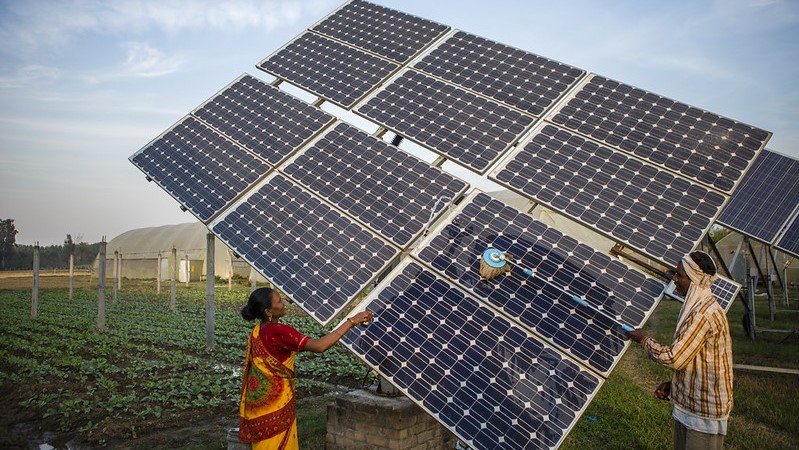Country must devise region-specific climate strategies to reach its climate goals, say experts
In such a geographically diverse country as India, each state and Union Territory (UT) has its own set of challenges and priorities when it comes to dealing with the growing impacts of climate change. It is thus imperative to have tailored and region-specific climate strategies to both, achieve the subnational as well as national climate goals. Actions by some Indian states and UTs are already playing a pivotal role in leading India’s road to carbon neutrality.
To shine a light on these actions, Climate Group in partnership with Climate Trends, convened state governments and a leading funding agency during Climate Week New York in September 2021, to discuss challenges, opportunities, and the role these key stakeholders are playing in this transition in the country. Aarti Khosla, founder and director, Climate Trends, moderated a discussion with representatives from two Indian states, Bihar and Gujarat, and the UT of Ladakh, to hear their priorities and actions they are taking to tackle climate change in their states.
Akhilesh Magal, head, renewable advisory, Gujarat Energy Research and Management Institute (GERMI), alluded to a recent research piece, which highlighted the trajectory Gujarat needs to take to operationalise the no new coal announcement, and the urgency of transforming the power sector. India is already witnessing a shift—as renewables become more economically viable in the country and Gujarat has the potential to become a solar- and wind-rich state. The research highlighted by Magal, during the discussion, illustrated that energy demand can be met by aggressive renewable energy targets in the state.
“We won the battle globally. Renewables today–solar and wind—are already cheaper. We really need to focus on industrial production and agriculture. If we start looking at it sector-wise and use the bottom-up approach to complement the top-down approach then net zero is something we should easily hit by mid-century,” Magal said.
Bihar is one of the most vulnerable states in India to the impacts of climate change. The state government recently signed an MoU with UNEP to work on a low-carbon pathway action plan for the state. Dipak Kumar Singh, principal secretary, environment, forest, and climate change department, Bihar, joined the discussion to highlight the importance and urgent need to increase sink cover and lower emissions to tackle the impacts of climate change, not just for the state, but nationally as well. “The 2050 or 2040 targets are immaterial unless we mainstream environmental concerns into the policymaking of all departments. There are two important things to achieve carbon neutrality–increase sink capacity and reduce total emissions. If policies and activities of all departments of all sectors are geared towards this, then we can achieve carbon neutrality,” Singh said.
Being a glacier region, Ladakh is under severe stress. Due to climate change, the glaciers in Ladakh are retreating, hence carbon neutrality and mitigating the impacts of climate change is critical for the UT. Carbon Neutral Ladakh, is an inspiring and ambitious vision set by Prime Minister Narendra Modi last year. Ravinder Kumar, secretary, power development department, UT of Ladakh, highlighted the multiple ongoing and planned projects in the UT–from a 10-gigawatt solar plant project to green hydrogen for electric mobility to name a few, which will turn the carbon neutrality vision into a reality for the UT. “We are using solar technology and focusing on carbon neutrality in the government departments. If every department starts working on this and has its own target, then it will be easy for us to achieve our goal of carbon neutrality as announced by the prime minister last year,” Kumar said.
The discussion ended with a key intervention from Moutushi Sengupta, India director, MacArthur Foundation, who emphasised the importance of states and regional actors in the fight against climate change from a funder’s perspective. “States play an important role in terms of enabling India to achieve its climate goals. From a funder’s perspective, the importance of supporting action against climate change is growing by the day. We would look at supporting India to achieve its domestic ambitions by enabling regional actors, including the states, to achieve their targets,” Sengupta said.
As countries are gearing up for COP26, the spotlight is on India to enhance its climate ambition and showcase greater climate leadership. Beyond the current commitments and climate initiatives, India is well placed to champion the cause and prioritise climate action to ensure a just and equitable transition to a low carbon future.
At the same time, it is essential to pass the mic to subnational actors as they map their journey for a low-carbon future in their respective regions. It is pertinent for voices from the Global South to be showcased in the upcoming discussions as leaders gear up for COP26. The discussion touched upon various challenges state governments face. However, the effort and measures taken to overcome them and emerge as climate action leaders sets the example for other states in the country. It is more critical than ever to bring climate action to the forefront of all policy making and to prioritise and focus on climate action across sectors. Setting climate action targets is important. However, it is equally essential to pave out concrete ways to implement them and ensure a just, equitable and low-carbon future aligned with what scientists have been advising us time and again.
The event can be watched here.
About The Author
You may also like
Why Global Banks Are Exiting From the Net-Zero Banking Alliance
India’s climate finance revolution: how financial institutions can transform with the new taxonomy
EU’s CBAM to Have Minor Impact on Indian Exports Initially: Report
Inside COP30 Circle of FM Report: A Path to the $1.3 Trillion Goal
Climate Governance Shows Progress, But Gaps Still Remain 10 yrs After Paris Agreement: Report

